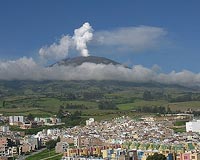| . |  |
. |
San Diego (SPX) Dec 07, 2009 A new study by an international research team has opened up a window into the earth to reveal Hawaii's deep roots and the best picture yet of a plume originating from the lower mantle. The findings suggest that the Hawaiian hot spot is the result of an upwelling high-temperature plume from the lower mantle. The project, called the Plume-Lithosphere Undersea Melt Experiment (PLUME), deployed a large network of seafloor seismometers at 73 sites off Hawaii during four research cruises over more than two-years. It represented the largest ocean-bottom seismometer (OBS) experiment in the world, reaching deeper into the lower mantle than previous experiments. The study, titled "Mantle Shear-wave Velocity Structure beneath the Hawaiian Hotspot," is published in the Dec. 4 issue of Science magazine. The Hawaiian volcanoes are a classic example of the unique type of volcanic activity that occurs in the interior, rather than at the edges, of the earth's tectonic plates. Geophysicist Gabi Laske of the Scripps Institution of Oceanography at UC San Diego led the PLUME experiment. Laske's research involves long-term, ocean-bottom earthquake monitoring to find and image the plume that gives rise to spectacular Hawaiian island chain of volcanoes and to better understand how they are fed by a super-heated plume from deep in the earth. "The PLUME team has unambiguously traced the Hawaiian plume from the seafloor through Earth's mantle transition zone," said Laske. The transition zone was previously thought to be a layer that obstructs whole-mantle convection between the core and the surface of the planet. The seismometers were used to record the timing of seismic shear waves from large earthquakes (magnitudes greater than 5.5) around the world. This information can be used to determine whether seismic waves travel more slowly through hot rock as they pass beneath Hawaii. Combining the timing measurements from many earthquakes recorded on many seismometers allowed researchers to construct a sophisticated three-dimensional image of the Hawaiian mantle. The large, 1,000-kilometers (621-miles) wide aperture of the seafloor ocean bottom seismometer network, developed at Scripps yielded unprecedented precision and resolution in a remote oceanic region and included SKS waves, a type of wave that travels through the earth's core, was critical for extending the imaging down to 1,500 kilometers (932-mile) depth. Researcher John Collins from Woods Hole Oceanographic Institution also developed new instruments for the experiment. Strikingly, the plume tilts toward the southeast of Hawaii as it extends downward. Such southeast tilting is consistent with prior dynamic predictions that the background circulation of Earth's mantle associated with plate tectonics will deflect the upwelling Hawaiian plume. Similar to rising smoke on a windy day, the Hawaiian plume is blown in the background mantle wind. The location of the Hawaiian Islands in the middle of the Pacific Ocean had hampered past seismological efforts to resolve the plume's deep structure. Seismometer deployments limited to just land sites on the islands did not provide sufficient coverage for high-resolution imaging, and Hawaii is also far from the most active circum-Pacific zones of earthquakes. As a result, scientists had to turn to a more technologically challenging marine seismology approach by placing temporary instrumentation on the seafloor to record seismic waves for two one-year deployments. Results of the project indicate a strong case for the existence of a deep mantle plume, which has fundamental implications-not just for Hawaii, but more generally for the form of convection in the solid Earth, Earth's composition with depth, its evolution over geologic time and how the earth releases heat. "This experiment was first conceived by our team a decade ago. Fortunately, the results have been worth the wait and exceeded all expectations," said Cecily Wolfe, professor at the University of Hawai'i and the paper's lead author. "The data collected by the PLUME experiment helped pioneer an entirely new class of marine seismology research," said Scripps professor John Orcutt and a co-author of the paper. "The state-of-the-art broadband OBS instruments developed at Scripps represent a great advancement for seafloor seismology." Authors are C.J. Wolfe, University of Hawaii at Manoa; S.C. Solomon and E.H. Hauri, Carnegie Institution for Science; G. Laske and J.A. Orcutt, Scripps Institution of Oceanography; J.A. Collins and R.S. Detrick, Woods Hole Oceanographic Institution; and D. Bercovici, Yale University. The PLUME project is supported by the National Science Foundation. Share This Article With Planet Earth
Related Links Scripps Institution of Oceanography Bringing Order To A World Of Disasters When the Earth Quakes A world of storm and tempest
 Colombia volcano eruption subsides, evacuation continues
Colombia volcano eruption subsides, evacuation continuesBogota (AFP) Nov 21, 2009 A volcanic eruption has eased enough to allow a local airport to open, but thousands of people are staying clear of Colombia's most active volcano as more activity is feared, authorities warned Sunday. Ashes are still falling near the Galeras vocano in the south, after Friday's eruption, but a color-coded alert has been lowered from red to orange, the Colombia Institute of Geology and Mining ... read more |
|
| The content herein, unless otherwise known to be public domain, are Copyright 1995-2009 - SpaceDaily. AFP and UPI Wire Stories are copyright Agence France-Presse and United Press International. ESA Portal Reports are copyright European Space Agency. All NASA sourced material is public domain. Additional copyrights may apply in whole or part to other bona fide parties. Advertising does not imply endorsement,agreement or approval of any opinions, statements or information provided by SpaceDaily on any Web page published or hosted by SpaceDaily. Privacy Statement |